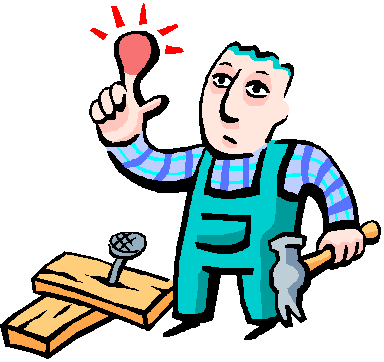
LESSON:
ORIENTATION AND SAFETY
OBJECTIVES:
1. TO REVIEW COURSE CONTENT AND DESIGN .
2. TO IDENTIFY COURSE EXPECTANCIES AND ASSIGNMENTS.
3. TO IDENTIFY THOSE AGRICULTURAL MECHANICS INSTRUCTIONAL UNITS
IN WHICH SKILL DEVELOPMENT IS NECESSARY.
4. TO REVIEW LABORATORY SAFETY MEASURES.
5. TO DEVELOP ORDER FORMS FOR PERSONAL SAFETY EQUIPMENT AND
PROFESSIONAL REFERENCE MATERIALS .
SAFETY
INVENTORY
Please initial that you have read and will observe each of the following safety
rules.
Personal
1. Safety glasses or goggles must be worn immediately upon entering the
shop work area .
2. Full cover work cotton clothing or coverall are the only permissible shop
working apparel.
3. Short sleeves are not permitted when arc welding.
4. Only full cover-all work shoes or boots are permitted.
5. Torn or ragged clothing may be the cause of a clothing fire.
6. Exceptionally long hair will be netted or covered with a skull cap.
7. Facial fires can result from long growth of beards when arc or oxy-acetylene welding.
8. All jewelry will be removed from fingers when working in the shop. This
includes wedding rings.
9. A skull hat or cap will be worn when welding. use
the oxy-acetylene welding or cutting torch without protective colored goggles
and gloves.
12. The fire blanket is designed to extinguish clothing fires. Its location
and how it is to be used has been explained. machinery is dangerous because the glove may be
caught, pulling the hands into the machine.
14. The legs of trousers must be free of upturned cuffs.
17. Oily or
otherwise dirty clothing is a fire hazard.
18. The instructor has the prerogative to restrict a student from
the shop laboratory area when safety and health of the individual is in
jeopardy.
return
to top
Use
of Hand Tools
1.
Use hammers only on hammer struck tools; never strike one hammer against
another!
2. An adjustable open-end wrench is designed to apply pressure by pulling toward
the stationary jaw.
1.
Never leave a power tool running and unattended.
2. Quickly inspect all power cords of portable electric equipment for exposed
wires or damaged sections before use.
3. Do
not attempt to "jury-rig" electrical receptacles. Use standard plug
caps.
return
to top
Safety
Tests
Bench
or Floor Stand Grinder
Indicate whether the statement represents a
safe or unsafe practice by placing and S or u in the space to the left of the
statement.
1.
Regardless of what you are doing, wear eye protection around - or working at a
grinder.
2. If a wheel vibrates because of being out of
round, true it with a wheel dresser .
3. Tool rest should be adjusted for approximately 1/4" space between wheel
face and rest.
4. Stand in alignment with a wheel as the motor is being started.
5. Wear gloves when grinding small hand tools and parts .
6. If the cutting action is slow force the piece into the wheel.
for rough grinding.
7. Mount a grinding wheel with only one wheel flange used.
8. Leave a grinder running to check the fit of a piece of pipe being ground to shape.
9. Grind on the side of a straight wheel.
10. Install a wheel marked for 3000 RPM on an arbor that rotates at 3600.
11. Be sure grinder is grounded before using, especially the portable
type.
12. Cracked wheels are safe to use if the arbor nut is tightened
sufficiently.
Signed:
Radial
Arm Saw
Indicate
in the space to the left of the statement whether the operation or practice is
safe or unsafe. Use "S" for safe and "U" for unsafe.
1. Always check to see that all locking clamps and handles have been tightened
before starting the saw's motor.
2.
When doing cut-off work, the saw is pulled firmly through the stock;
never is it pushed into the material.
3.
During "ripping, the feeding operation should be from the side of the saw
opposite the anti-kickback device.
4.
The front edge of the Guard is adjusted to clear the stock " by 1/8"
when ripping .
5.
Rip a piece of stock which is 12 inches long, place the saw in the cross-cut
position and pull the saw through the stock.
6.
If a person is working a short distance from the saw , but is in direct
alignment with the blade's rotation, warn him/her of your intentions to start the saw and ask
him/her to move out of the way.
7.
Allow the blade to coast to a stop before attempting to change saw set ups .
8.
Properly rip a piece of stock with safety, always position the anti-kickback
device so that it properly grabs the stock.
9.
If a finished piece of plywood was to be sawn in the cut-off position, the
finished side would be "up" on the table.
10.
return
to top
Portable
Electric Drill
Indicate in the space to the left of the statement whether the operation or
practice is safe or unsafe. Use "S" for safe and "U"
for unsafe.
1. Always pl the drill into a grounded outlet .
2. Stop the chuck from rotating turn off the switch and slow the chuck rotation
by letting it slip in the hand.
3. If the bit gouges and starts to twist the entire frame, drop the drill and
pull the power cord .
4. When drilling deep holes, lock the switch to the "on" position with
the lock bolt on the handle.
5. When changing tools in the chuck, disconnect the power cord.
6. Securely hold large 1/2" drills using both hands on the tee handles.
7. Remove the key from the chuck before starting motor.
Signed:
return
to top
Portable
Electric Saw
Indicate
in the space to the left of the statement whether the operation or practice is
safe or unsafe. Use "S" for safe and "U" for unsafe.
1.
Plug the electric cord into an ungrounded receptacle.
2. Adjust the depth of cut so that as much of the blade as possible projects
through the work.
3. When changing blades, disconnect the power cord.
4. Short pieces can be safely held by the left hand when using the portable
saw.
5. Wear goggles only when cutting or sawing metals.
6. Use a saw with a dull blade.
7. Feed the saw after the blade has reached full speed.
8. Hold the guard open with the tips of the fingers of the left hand.
9. Rest the saw in a sawhorse cradle or off the floor.
10. Brush sawdust away from a moving blade.
11. Rip or cut long pieces free hand when you could use a guide blade. 12..
Plug a 120 volt motor into a 230 volt receptacle.
13. Have the shoe resting on the cut-off stock.
14. Adjust the angle or depth of cut with the motor running.
Signed
return
to top
Oxy-Acetylene Welding
On the
blank preceeding the statements below, indicate whether the practice would be safe or
unsafe. Mark with an S those that
are safe and U for those that are
unsafe.
1.
Matches are acceptable for lighting the torch.
2. Before installing a new oxygen regulator on the cylinder
properly grease the fitting.
3. Use soapy
,.water to check for leaks .
8. Oxygen and acetylene cylinders chained n a
vertical position
9.
Removing all combustible materials from the area before lighting the
torch
10. Using
recommended operating pressure for oxygen and acetylene.
Signed:
return
to top
Arc
Welding
Indicate
in the space to the left of the statement whether the operation or practice is
safe or unsafe. Use "S" for safe and "U" for unsafe.
1.
Barrels which are empty of combustible materials are all right to weld without
further preparation.
2. Long sleeve shirts or coveralls are essential to protect the skin from burns
by ultraviolet rays.
3. Arc welding is always done in a well ventilated area.
4. Flame resistant and insulating gloves are worn so that hot metal may be
handled without additional equipment.
5. An arc welding helmet with clear lens is ample protection. from arc welding
rays.
6. Always give warning to persons nearby before proceeding to strike an
arc.
7. When not wearing; eye protection always '"chip" away from your
face.
8. Avoid damp areas when using an arc welder.
9. Loose connections in an arc welder circuit make for a better flow of
current.
10. Do not look at the arc produced by another person who is welding.
11. Wear a skull cap to protect the scalp from possible disease and hair being
ignited.
Signed:
return
to top
Order
safety jackets from a variety of locations. They should be 100% cotton.
National
FFA Ventures Marketing Group

 The University of Arizona
The University of Arizona![]()